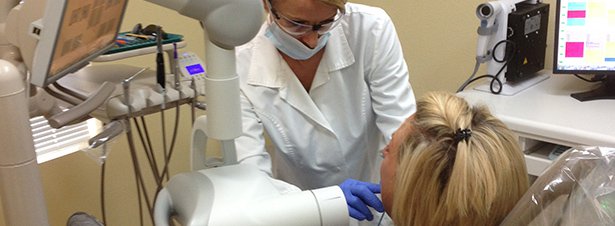
When Dr. Tony Hewlett, DDS, entered into private practice in 1985, he pledged that he would always stay ahead of the curve by investing in the latest technologies. He is proud that his practice — Tony Hewlett, DDS, Family Dentistry — was an early adopter of digital technology, having made the switch from film x-rays to Schick digital intraoral radiography in 1996. A long-time Sirona customer, Dr. Hewlett just recently upgraded his practice to the new Schick 33 sensor.
Putting Patients First
Dr. Hewlett’s dental practice serves families throughout Stanwood, Wash., and maintains six operatories, including one for emergencies and two for restorative treatments.
With more than 28 years of experience in the dental industry, Dr. Hewlett says that staying current with the most advanced technologies is a vital component of providing high-quality patient care. He always looks to improve the patient experience through both better diagnostics and improved level of comfort.
Dr. Hewlett first started looking into digital radiography after his patients expressed concerns about the radiation levels associated with film x-rays. Although the amount of radiation used for film is relatively small, the effect on a human body is cumulative over a lifetime. Digital radiography, however, has the capability to significantly reduce radiation levels.
An additional benefit of digital radiography for Dr. Hewlett was the ability for almost immediate imaging results. Film x-rays require long processing times, and when he and his staff have to attend to an emergency patient and assess a problem area, the schedule suffers. Now it only takes a few seconds to take an image so they can assess a patient’s needs.
Once Dr. Hewlett completed his research on digital intraoral sensors, it was important for him to get staff support before making the switch. Although there would be a slight learning curve as they collectively became acquainted with the new equipment and techniques, it was a unanimous decision to move toward digital.
Digital Makes a Difference
Since switching to digital, Dr. Hewlett has seen firsthand how the technology positively affects the patient experience and the way his practice operates on a daily basis.
“With digital, we’re now finding things earlier than we would normally and we’re catching things that would be major issues down the road,” said Dr. Hewlett. “Digital radiography has improved our diagnostics and today, we’re doing more conservative dentistry.”
Using the Schick 33’s image management system, Dr. Hewlett and his staff have the ability to manipulate images to give patients a more personalized view and a better understanding of their oral health. He credits digital radiography for playing a major role in increasing treatment acceptance.
“When we take a digital x-ray using the Schick 33, patients are able to see the decay, the fillings, and the hidden wisdom teeth. When we use the CEREC dental restoration system, patients can watch me design it and they get what I’m doing and why,” he said.
The switch to digital has also reduced patient wait time and completely eliminated the processing time associated with film. Additionally, the Schick sensors fit more comfortably for patients, allowing staff to take the right shot on the first attempt, reducing the need for retakes.
Patients today can be treated in a timelier manner. The quick digital results have also proven to be beneficial when working with insurance companies and providing patient referrals.
“Thanks to digital, we are now more efficiently seeing our patients,” said Dr. Hewlett. “When an emergency patient comes in, we can stay on schedule because we can get that image immediately and discuss our recommendations.”
Digital Diagnostics Promote Better Dentistry
Dr. Hewlett now refers to digital intraoral radiography as his biggest marketing tool. In fact, he said he’s gained new patients because of his technology. Dr. Hewlett’s office is state of the art. It runs completely paperless, actively engages with patients on Facebook and communicates with patients via text messaging.
“Today’s world is digital, and it’s what patients have come to expect, even at the dentist’s office,” said Dr. Hewlett. “Taking the practice digital has been one of the best decisions for my patients and my staff.”
Share with your colleagues